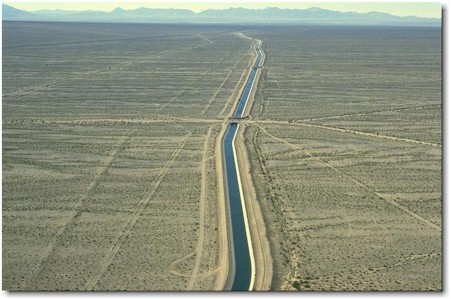As I wrote in a March 2016 Hydrowonk Post, the El Niño rains did not provide even drought relief across the western United States. Some areas have seen record rainfall. For example, Houston, Texas recorded the wettest April on record this year. A slow moving storm from April 15-18 dumped almost a foot of rain in some areas of greater Houston, more than 3 times the average rainfall for the entire month of April. The Pacific Northwest also received very plentiful rainfall. At the beginning of the water year (September 30, 2015), Washington State had 100% of its land mass covered in some form of drought according to the US Drought Monitor. As of this week, 96.71% of the state was drought-free. Unfortunately, not all areas in the west fared as well as the Pacific Northwest in terms of drought relief. Continue reading
Category Archives: Colorado River Basin
California and Florida: Coasts Apart, but Facing Similar Challenges Related to Drought and Saltwater Intrusion
California and Florida may be on opposite coasts, but they have more similarities than you may expect in relation to water supply challenges. While California and much of the Western Unites States remains in the grip of a long-term drought, the Southeastern United States has quietly and unfortunately also entered into drought. Southern states including Florida, South Carolina, Alabama and Louisiana are experiencing drought conditions, in some cases severe. The most recent US Drought Monitor shows that while drought conditions in the Sunshine State have abated somewhat, approximately 27.1% of Florida is experiencing some level of drought. The drought conditions are at their worst near the population centers of Tallahassee in the north and Miami in the south. Just a month ago, close to 40% of the state was in some form of drought and extreme drought covered parts of Southeastern Florida west of Miami. Continue reading
Southern Nevada’s Water Supply through the Drought – Making the Most of Limited Water Supplies
In the drought-parched Western United States, it is hard to find a silver lining in the economic and social costs that the long-term drought has caused. But at Lake Mead on the Colorado River, people are trying to make the most of the limited water supplies and take advantage of the unique sights that the low water levels have revealed. In late July, CBS News reported that the exceptionally low lake levels have revealed interesting historical attractions that up until the drought, were essentially unreachable. The receding shoreline revealed the foundations of Saint Thomas, a pioneer town that Mormon settlers founded in 1865. Until the US government purchased the land in the 1930s, the town was inhabited and included a school, homes, a general store and ice cream parlor. In the 1990s, 100 feet or so of water would have covered the ruins of Saint Thomas. Now, visitors can hike for about a mile across the desert to reach the foundations of the former town. Continue reading

Thinking About the Availability of Wheeling Capacity on the Colorado River Aqueduct
With the implementation of the Quantification Settlement Agreement in 2003, the amount of Colorado River water available to the Metropolitan Water District of Southern California has been less than the capacity of the Colorado River Aqueduct (“CRA”). For example, the Bureau of Reclamation currently forecasts that Metropolitan’s use of Colorado River water will be 861,616 AF in 2015 http://www.usbr.gov/lc/region/g4000/hourly/forecast15.pdf. This is 438,834 AF less than the historical maximum annual amount of 1.3 million AF of Colorado River water conveyed through the CRA. Continue reading
